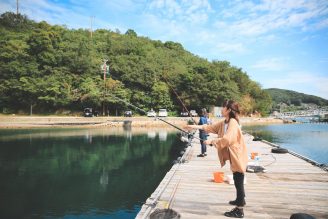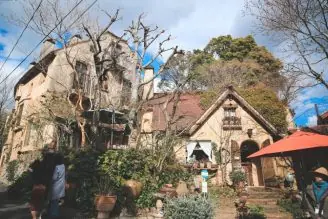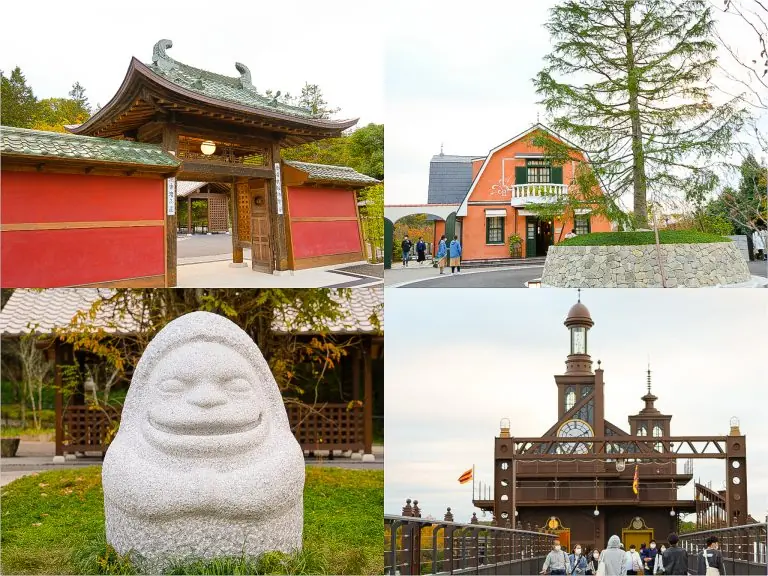"Eiho-ji Temple," a temple with a magnificent garden and national treasures recommended during the fall foliage season.

Table of Contents
It's the season when autumn gradually deepens. In November, autumn leaves are at their best in various places. Eiho-ji Temple in Tajimi City, Gifu Prefecture is a temple that you should definitely visit during the fall foliage season.
This temple was built in 1313 during the Kamakura period (1185-1333), and the Kannondō and Kaisandō, built in the late Kamakura period (1185-1333), are designated as national treasures. Its garden, with its Chisen Kaiyu style, is of great artistic and ornamental value to Japan, and the temple is one of the most famous temples in Gifu Prefecture designated as a national place of scenic beauty. In autumn, the temple grounds are at their best when the autumn leaves, including the 700-year-old giant ginkgo tree, are in full color.
History of Eiho-ji Temple
 Eihoji Main Hall
Eihoji Main Hall
First, we would like to briefly talk about the history of Eiho-ji Temple.
The official name of Eiho-ji Temple is "Rinzai-shu Nanzen-ji ha Kokeizan Eiho-ji". The name "Kokei" is said to have originated from the fact that when Muso Soseki, a Zen monk of the Rinzai sect, visited this area, it resembled the scenery of Kokei in Rozan, China (currently a World Heritage site).
Eiho-ji is a temple built in 1313 by Muso Soseki, a Zen priest of the Rinzai sect. Muso Soseki is also famous as a master of gardens, leaving behind many famous gardens such as Zuisenji in Kamakura, Kokedera and Tenryuji in Kyoto. In 2003 (Heisei 15), a fire destroyed the Hondo (main hall) and the Kuri (kitchen.) However, thanks to the cooperation of citizens wishing for the reconstruction of Eiho-ji Temple, fund-raising activities were carried out, and in 2007 the Kuri was restored, and in June 2011 the Hondo was restored to its original appearance before the fire.
Today, the temple is also gaining popularity as a place to hold a "Zen-style wedding ceremony" inside the national treasure Kannon Hall and on the temple grounds. From here, we have actually visited Eiho-ji Temple to pay our respects, and we will report on our visit.


Eihoji Temple is about 10 minutes from Tajimi Station. Buses are also in operation. Free parking is available just before crossing the tracks.
Eiho-ji Temple with a splendid garden

After parking the car, walk to the precincts of Eiho-ji Temple.
A beautiful garden welcomes you as you enter the precincts. This garden is called Chisen Kaiyushiki style garden, and has been designated as a national scenic spot as a famous garden that retains the characteristics of Soseki Muso.
 When we looked into the pond, carps gathered.
When we looked into the pond, carps gathered.

The pond in the garden is Garyo Pond, and the bridge in the center is Musai Bridge. This bridge is said to connect the world of Shigan (this world), which is filled with worldly desires, and the world of Higan (the other world,) which is free from worldly desires. It has been selected as one of the 100 famous bridges in Japan and is very tasteful.
 Since the expression of the bridge changes depending on the angle, everyone was shooting the bridge from various angles.
Since the expression of the bridge changes depending on the angle, everyone was shooting the bridge from various angles.

Rokkakudo is built on the rock. A thousand Jizo statues are enshrined here. A Jizo is borrowed by a person who makes a wish, and when the wish is granted, it is returned with a new Jizo.

After crossing the bridge, you can see Kannon-do. It is also called "Kannon-kaku" or "Suigetsujo" and is designated as a national treasure. The curve of the roof unique to Zen Buddhism is very beautiful.

Standing quietly behind the Kannondo is the Kaisando, which is also designated as a national treasure. It is said to be a representative building that conveys the Zen sect style of the early Muromachi period. In the hall, the Buddha statues of Muso Soseki and Geno Hongen, who were involved in the founding of Eiho-ji Temple, are enshrined.

The ginkgo tree, which is 25m tall and about 700 years old, is also worth seeing. In December, a little after the fall foliage season, the ginkgo leaves turn golden.



![[Tokai Area] Shrines and Temples](https://life-designs.jp/wp/wp-content/uploads/2022/03/4b6784b9a0a6f408160ee9c32a307138-1024x580.png)







![[Tajimi city] "PRODUCTS STORE" Proposes Vessels that Value Stories](https://life-designs.jp/wp/wp-content/uploads/2022/01/image9-5-1-1024x683.jpg)
![[Tajimi, Gifu] Terrace Cafe Oribe where You can Relax while Looking at the Superb View](https://life-designs.jp/wp/wp-content/uploads/2022/01/image9-11-1-1024x683.jpg)
![[Tajimi] Taste the Exquisite Spice Curry at "cafe NEU!"](https://life-designs.jp/wp/wp-content/uploads/2019/06/IMG_0877-1-1024x682.jpg)


![[Indoor Facilities] Where to Go on Rainy Days in Tokai Area! For Family Outings!](https://life-designs.jp/wp/wp-content/uploads/2023/07/FotoJet-23.jpg)





![[Tokai Area] Scenic Spots which You'll Never Forget](https://life-designs.jp/wp/wp-content/uploads/2019/12/LD_banner_w1920x1088_prospect-1-768x435.jpg)

![[Tokai Area] Place to Go on Rainy Days!](https://life-designs.jp/wp/wp-content/uploads/2022/03/f76405aaa33944a4ba88a131fbc56523-1024x580.png)
![[Osu Special Feature] A City of History and Uniqueness](https://life-designs.jp/wp/wp-content/uploads/2022/03/01_Osu-1-1024x580.png)
![[Nagoya-meshi] Nagoya's Speciality Dishes](https://life-designs.jp/wp/wp-content/uploads/2022/06/5ba2ca8c038fd4af7527bc0826367cfb-1024x580.png)
















































![[28 selections] I want to get it when I go to Ghibli Park! Recommended goods & souvenirs (Ghibli’s Grand Warehouse edition)](https://life-designs.jp/wp/wp-content/uploads/2023/07/07bb34f30842ccc4c6412fc060e1966c-1024x683.jpg)

![[9 Selections] Summary of Retro Coffee Shops in Nagoya](https://life-designs.jp/wp/wp-content/uploads/2021/11/image1-30-1024x683.jpg)
![[20 Selections] Nagoya Souvenirs: Non-Sweet & Recommended Snacks Available at Nagoya Station](https://life-designs.jp/wp/wp-content/uploads/2025/07/image3-2-1024x683.jpg)

![[Within 2hrs by Car] 12 Outing Areas where You can Go on a Day Trip from Nagoya!](https://life-designs.jp/wp/wp-content/uploads/2023/07/odekake12_w1200h900_20240422-328x246.png)
![[Aichi, Gifu, Mie] 30 Family-Friendly Spots to Go in Winter!](https://life-designs.jp/wp/wp-content/uploads/2019/12/image21-1-150x106.png)

![[Nagoya, Aichi] Recommended Shops to Buy Tablewares around Nagoya](https://life-designs.jp/wp/wp-content/uploads/2019/11/image12-26-150x100.jpg)
